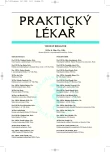Injury to the ankle in the growing skeleton
Authors:
T. Pešl; P. Havránek
Authors‘ workplace:
Přednosta: prof. MUDr. Petr Havránek, CSc.
; 3. lékařská fakulta a FTNsP Praha
; Klinika dětské chirurgie a traumatologie
; Univerzita Karlova v Praze
Published in:
Prakt. Lék. 2008; 88(7): 384-387
Category:
Of different specialties
Overview
Ankle fractures are distal tibial and fibular fractures that occur at or distally from the level of the metaphysis. Defining the cutoff between a pediatric and an adult fracture is somewhat arbitrary; the upper age limit of eighteen years is often used. Alternatively, pediatric fractures may be defined as those that occur in individuals with open physes regardless of chronologic age. The potential complications associated with pediatric ankle fractures include those also seen with adult fractures (posttraumatic arthritis, ankle stiffness) as well as those that result from epiphyseal damage, i.e. growth impairment (leg-length discrepancy, angular deformity, or a combination of the both). The goals of treatment are to achieve and maintain a satisfactory reduction and to avoid epiphyseal arrest. A knowledge of common pediatric ankle fracture patterns and the basic principles of their treatment will aid the effective management of these injuries.
Key words:
Physis, distal tibia, ankle joint, fracture, child.
Sources
1. Aitken, A.P. The end results of the fractured distal tibial epiphysis. J. Bone Joint Surg. 1936, 18, p. 685-691.
2. Bartoníček, J., Doskočil, M., Heřt, J., Sosna, A. Chirurgická anatomie velkých končetinových kloubů. Praha: Avicenum, 1991.
3. Cooperman, D.R., Spiegel, P.G., Laros, G.S. Tibial fractures involving the ankle in children: The so-called triplane epiphyseal fracture. J. Bone Joint Surg. 1978, 60-A, p. 1040-1046.
4. Crawford, A.H., Al-Sayyad, M.J. Fractures and dislocations of the foot and ankle. In: Green, N.E., Swiontkowski, M.F. (eds) Skeletal trauma in children. Philadelphia: Saunders, 2003, p. 516-586.
5. Dias, L.S., Tachdjian, M.D. Physeal injuries of the ankle in children. Clin. Orthop. 1978, 136, p. 230-233.
6. Gross, R.H. Ankle fractures in children. Bull NY Acad. Med. 1987, 63, p. 739-761.
7. Havránek, P. Dětské zlomeniny. Praha: Corvus, 1991.
8. Kay, R.M., Matthys, G.A. Pediatric ankle fractures: evaluation and treatment. Am. Acad. Orthop. Surg. 2001, 9, p. 268-278.
9. Kleiger, B., Mankin, H.J. Fracture of the lateral portion of the distal tibial epiphysis. J. Bone Joint Surg. 1964, 46-A, p. 25-32.
10. Lintecum, N., Blasier, R.D. Direct reduction with indirect fixation of distal tibial physeal fractures: a report of a technique. J. Pediatr. Orthop. 1996, 16, p. 107-112.
11. Love, S.M., Ganey, T., Ogden, J.A. Postnatal epiphyseal development: the distal tibia and fibula. J. Pediatr. Orthop. 1990, 10, p. 298-305.
12. MacNealy, G.A., Rogers, L.F., Hernandez, R., Poznanski, A.K. Injuries of the distal tibial epiphysis: systematic radiographic evaluation. Am. J. Roentgenol. 1982, 138, p. 683-689.
13. Marmor, L. An unusual fracture of the tibial epiphysis. Clin. Orthop. 1970, 73, p. 132-135.
14. Ogden, J.A. Injury to the growth mechanisms of the immature skeleton. Skeletal. Radiol. 1981, 6, p. 237-253.
15. Ogden, J.A., McCarthy, S.M. Radiology of postnatal skeletal development. VIII. Distal tibia and fibula. Skeletal Radiol. 1983, 10, p. 209-220.
16. Pešl, T., Havránek, P., Naňka, O. Mutual position of the distal fibular physis and the tibiotalar joint space. Eur. J. Pediatr. Surg. 2007, 17, p. 348-353.
17. Rang, M. Children’s Fractures. Philadelphia: Lippincott, 1983.
18. Salter, R.B., Harris, W.R. Injuries involving the epiphyseal plate. J. Bone Joint Surg. 1963, 45-A, p. 587-622.
19. Von Laer, L. Pediatric fractures and dislocations. Stuttgart: Thieme, 2004.
Labels
General practitioner for children and adolescents General practitioner for adultsArticle was published in
General Practitioner

2008 Issue 7
- Metamizole vs. Tramadol in Postoperative Analgesia
- Memantine in Dementia Therapy – Current Findings and Possible Future Applications
- Metamizole at a Glance and in Practice – Effective Non-Opioid Analgesic for All Ages
- What Effect Can Be Expected from Limosilactobacillus reuteri in Mucositis and Peri-Implantitis?
- Metamizole in perioperative treatment in children under 14 years – results of a questionnaire survey from practice
Most read in this issue
- Pernicious anemia
- Fractures that are hard to diagnose in the skeleton of a child
- V.A.C. therapy in the treatment of soft-tissue defects
- Chlamydia pneumoniae
